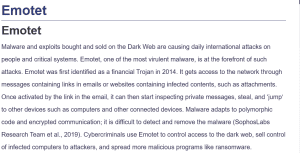Emotet
Malware and exploits bought and sold on the Dark Web are causing daily international attacks on people and critical systems. Emotet, one of the most virulent malware, is at the forefront of such attacks. Emotet was first identified as a financial Trojan in 2014. It gets access to the network through messages containing links in emails or websites containing infected contents, such as attachments. Once activated by the link in the email, it can then start inspecting private messages, steal, and ‘jump’ to other devices such as computers and other connected devices. Malware adapts to polymorphic code and encrypted communication; it is difficult to detect and remove the malware (SophosLabs Research Team et al., 2019). Cybercriminals use Emotet to control access to the dark web, sell control of infected computers to attackers, and spread more malicious programs like ransomware.
Emotet disrupts its targets severely and is active across industries such as the healthcare industry, financial institutions, and government organizations. For example, Emotet in 2020 disrupted several countries in Europe, causing data and financial loss in millions of US dollars, according to Symantec (2021). Since it can function as an entry point to even more dangerous malware, it is a significant threat that erodes organizational security and confidence.
Managing Emotet requires cooperation with other countries and utilizes modern technologies such as threat intelligence. This means that cybersecurity firms, as well as police forces, target Emotet’s infrastructure and try to eliminate it on the Dark Web; they also try to come up with strong, proper protection. Measures such as regularly scanning for such malware, educating employees on the existence of phishing, reminding them to be wary of phishing scams, and updating the software are some of the key approaches that must be employed to deal with such smart malware.
Emotet is a good example of what is happening on the Dark Web with malware and exploits. Due to its sophisticated features and its capacity to retrofit with other types of obfuscation, more powerful countermeasures are needed to address it and other novel threats.
References
SophosLabs Research Team. (2019). Emotet exposed: Looking inside highly destructive malware. Network Security, 2019(6), 6-11.
Symantec. (2021). Symantec internet security threat report. https://docs.broadcom.com/doc/istr-03-jan-en
ORDER A PLAGIARISM-FREE PAPER HERE
We’ll write everything from scratch
Question
Discussion Prompt: Stuxnet Virus on Iranian nuclear plant

Emotet
- Write a paper on Malware and Exploits on the Dark Web: example the Stuxnet Virus on Iranian nuclear plant .

